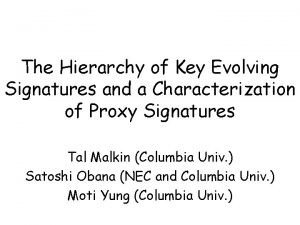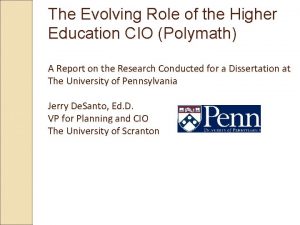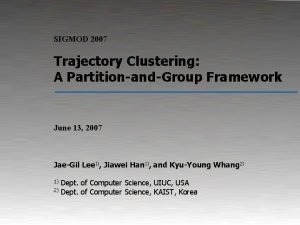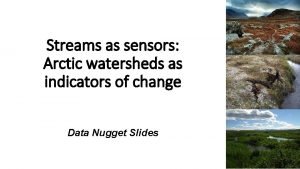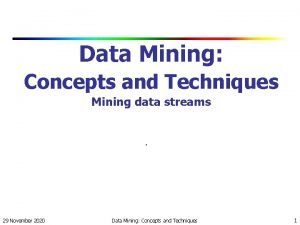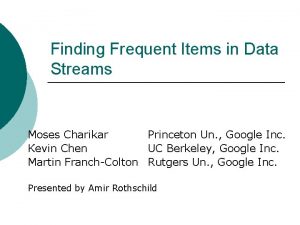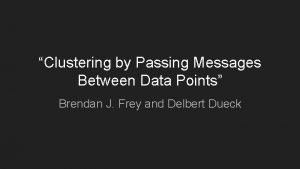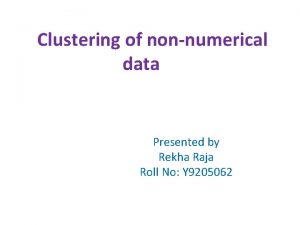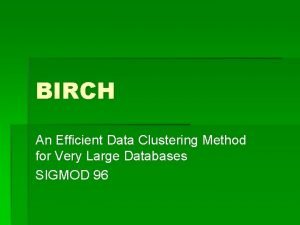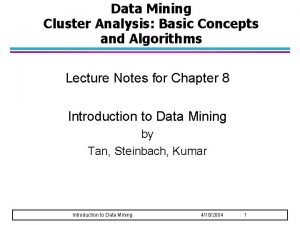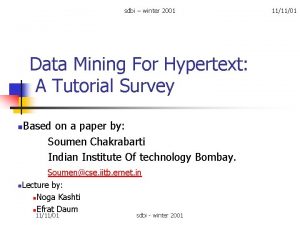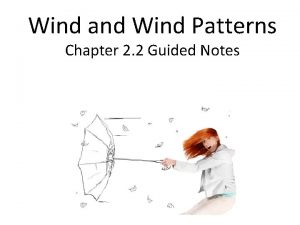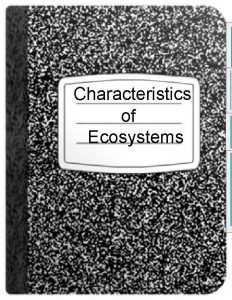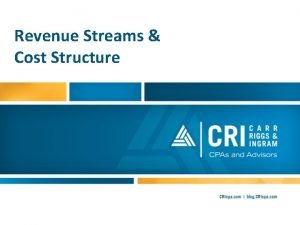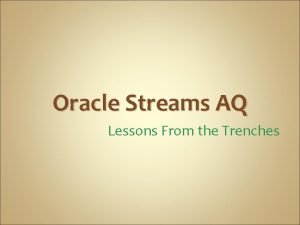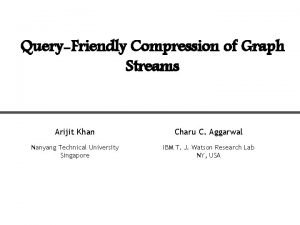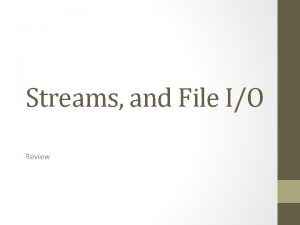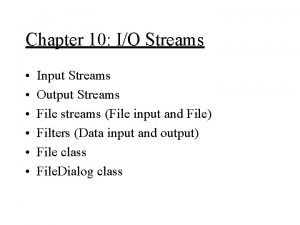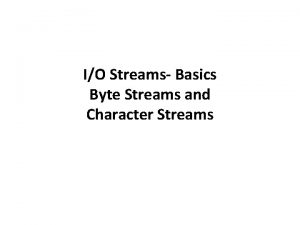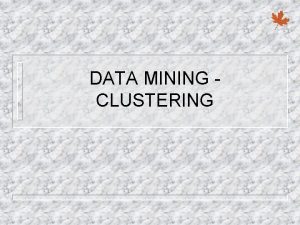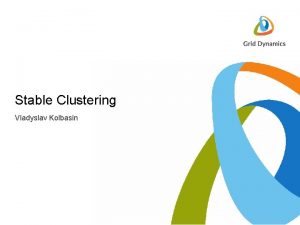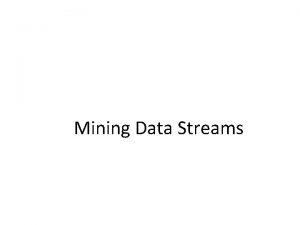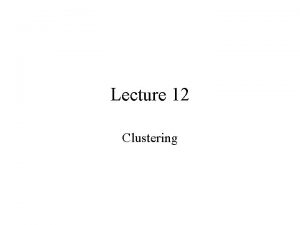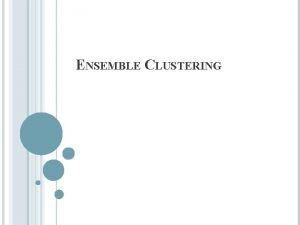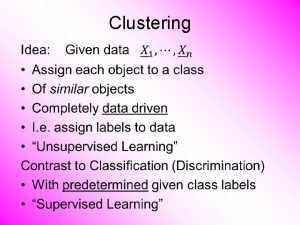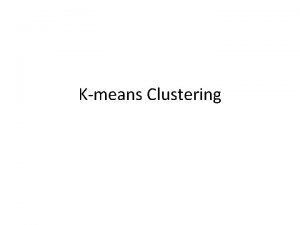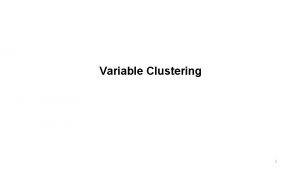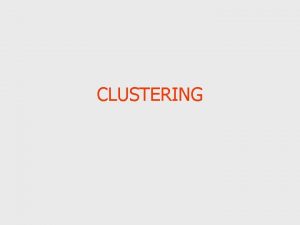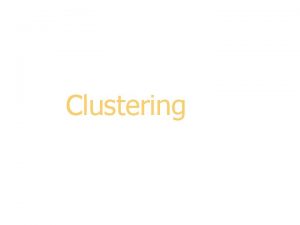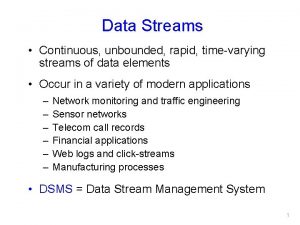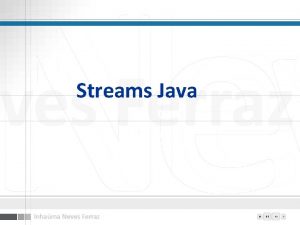A Framework for Clustering Evolving Data Streams Charu
















![Example C_ID: [C 1, C 2, C 3] Time: T C_ID: [C 1] Time: Example C_ID: [C 1, C 2, C 3] Time: T C_ID: [C 1] Time:](https://slidetodoc.com/presentation_image/4c7e70fbebda1e45bf31717e0bde9d1b/image-17.jpg)


![Counter Example C_ID: [C 1, C 2, C 3] Time: T C_ID: [C 2] Counter Example C_ID: [C 1, C 2, C 3] Time: T C_ID: [C 2]](https://slidetodoc.com/presentation_image/4c7e70fbebda1e45bf31717e0bde9d1b/image-20.jpg)

- Slides: 21

A Framework for Clustering Evolving Data Streams Charu C. Aggarwal, Jiawei Han, Jianyong Wang, Philip S. Yu Presented by: Di Yang Charudatta Wad

Outline l Background of Clustering l Motivation for Clustering over Streaming Data. l Overall Solution l Micro Clusters l Pyramid Time Frame l Macro Cluster l Cluster Maintenance

Background of Clustering l Definition of Clustering ¡ For a given set of data points, partitioning them into one or more groups of similar objects. ¡ “Similarity” is often defined with the use of some distance measure. l Difference clustering. between “group by” queries and

Background of Clustering l Some of the most popular clustering algorithms: ¡ K- Means, BIRCH, CURE, Density Based Clustering. l Clustering has many applications in data bases, information visualization, data mining. l What are Oultiers?

Motivation l Challenge in Streaming Environment: ¡ Clustering is an expensive process. ¡ Resource constraints. ¡ Infinite streams. l Can simply extending one pass algorithms for static databases to stream processing suffice?

Motivation l Requirements of clustering for stream processing: ¡ Statistical summary information storage. ¡ Efficient update process. ¡ Ability to cluster for a specific time horizon,

Overall Solution of the Paper l Divide the clustering process to two phases Online Component: periodically stores detailed summary statistics Offline Component uses only the summary statistics to do clustering

Micro-Clusters l What is a Micro-Cluster A Micro-Cluster is a set of individual data points that are close to each other and will be treated as a single unit in further offline Macro-clustering. View of Micro-Cluster View of Macro-Cluster

Micro-Clusters l What to Store in a Micro-Cluster = Key idea: Additivity Property

Pyramidal Time Frame l The micro-clusters are stored at snapshots. … … Snapshot l When should we make the snapshot? l The snapshots follow a pyramidal pattern

Pyramidal Time Frame Snapshots are classified into different orders which can vary from 1 to log α(T). For example, T is 55, α=2, then we have orders 0 with interval 2^0=1, order 1 with interval 2^1=2, order 2 with interval 2^2=4, order 3 with interval 2^3=8, order 4 with interval 2^4=16, order 5 with interval 2^5=32. l For a data stream the maximum number of snap- shots maintained at T time units since the beginning of the stream mining process is (α + 1) log α(T). (α + 1 for each order) l

Why Pyramidal Pattern? l For any user-specified time window of h, at least one stored snapshot can be found within 2 h units of the current time. Please Note: Only Approximate Answers!!!

Micro Cluster Creation l It is assumed that a total of q microclusters are maintained at any moment by the algorithm. l This is done using an offline process (kmeans) at the very beginning of the data stream computation process.

Online Micro Cluster Maintenance How to deal with a new coming point? 1. Join one of the old cluster 2. Create a new cluster by its own l How to deal with the old clusters 1. Delete them (based on relevance stamp) 2. Merge them (merge the closest two) l A merged cluster will have all the IDs its components have

Macro-Cluster Creation l Based on the Additivity Property of cluster feature vector

Macro-Cluster Creation Current Time T, the window size is h. That means the user want to find the clusters formed in (T-h, T). Approach: 1. 2. 3. 1 st step: Find the snapshot for T, get the micro-cluster set S(T). 2 nd step: Find the snapshot for T-h, get the micro-cluster set S(T-h). Use S(T)-S(T-h) Specifically, we have a merged cluster with Id list (C 1, C 2, C 3) in S(T) and a cluster with Id C 1 in S(T-h). Then the we use CFT(C 1, C 2, C 3)-CFT(C 1)=CFT(C 2, C 3), because C 1 are formed before T-h, thus should not contribute to the micro-cluster formed in (T-h, T)
![Example CID C 1 C 2 C 3 Time T CID C 1 Time Example C_ID: [C 1, C 2, C 3] Time: T C_ID: [C 1] Time:](https://slidetodoc.com/presentation_image/4c7e70fbebda1e45bf31717e0bde9d1b/image-17.jpg)
Example C_ID: [C 1, C 2, C 3] Time: T C_ID: [C 1] Time: T-h C_ID: [C 2, C 3] Result: T-h

Macro-Cluster Creation l Run K-means on Micro-Clusters

How do you feel about this paper? l My feeling: Quite Fuzzy Results: Approximation is every where. Nothing New: Micro-Clusters, K-means, Cluster Feature Vectors, Pyramidal Time Frame are all old stuffs.
![Counter Example CID C 1 C 2 C 3 Time T CID C 2 Counter Example C_ID: [C 1, C 2, C 3] Time: T C_ID: [C 2]](https://slidetodoc.com/presentation_image/4c7e70fbebda1e45bf31717e0bde9d1b/image-20.jpg)
Counter Example C_ID: [C 1, C 2, C 3] Time: T C_ID: [C 2] Time: T-h C_ID: [C 1, C 3] Result

Advertisement l 1. 2. 3. 4. 5. Di and Charu’s project deals with: Deterministic Clusters with Arbitrary Shapes Real Expirations Disk Version Outlier Detection by Free
 A framework for clustering evolving data streams
A framework for clustering evolving data streams Flat and hierarchical clustering
Flat and hierarchical clustering Partitional clustering
Partitional clustering Rumus distance
Rumus distance Charu mullick
Charu mullick Evolving design
Evolving design Key evolving signature
Key evolving signature Evolving
Evolving Trajectory clustering: a partition-and-group framework
Trajectory clustering: a partition-and-group framework Data nugget streams as sensors answers
Data nugget streams as sensors answers Basic concepts in mining data streams
Basic concepts in mining data streams Finding frequent items in data streams
Finding frequent items in data streams Clustering by passing messages between data points
Clustering by passing messages between data points Classification and clustering in data mining
Classification and clustering in data mining Clustering non numeric data
Clustering non numeric data Birch in data mining
Birch in data mining Clustering data mining
Clustering data mining K-means clustering algorithm in data mining
K-means clustering algorithm in data mining Types of jet streams
Types of jet streams Bill nye rivers and streams answers
Bill nye rivers and streams answers Cost streams
Cost streams Streams aq: waiting for messages in the queue
Streams aq: waiting for messages in the queue






